RBSE Class 8 Science Important Questions Chapter 9 Reproduction in Animals
Rajasthan Board RBSE Class 8 Science Important Questions Chapter 9 Reproduction in Animals Questions and Answers.
RBSE Class 8 Science Chapter 9 Important Questions Reproduction in Animals
Objective Questions
Question 1.
The following is not the viviparous animal:
(a) Human being
(b) Hen
(c) Dog
(d) Cow
Answer:
(b) Hen

Question 2.
The following is the oviparous animal:
(a) Frog
(b) Lizard
(c) Hen
(d) All of the above
Answer:
(d) All of the above
Question 3.
The following is not a part of male reproductive organ:
(a) Testes
(b) Sperm ducts
(c) Oviduct
(d) Penis
Answer:
(c) Oviduct
Question 4.
Asexual reproduction takes place by budding:
(a) In amoeba
(b) In paramecium
(c) In hydra
(d) In plasmodium
Answer:
(c) In hydra

Question 5.
The organism with largest egg is:
(a) Frog
(b) Human beings
(c) Hen
(d) Ostrich
Answer:
(d) Ostrich
Fill in the blanks
1. Testes is the ........................ reproductive organ.
Answer:
male
2. The ........................ of male and female gametes is called sexual reproduction.
Answer:
fusion

3. Fertilized egg is called ........................
Answer:
zygote
4. The new individual develop in hydra by ........................
Answer:
budding.
True/False
Indicate whether the following statements are true (T) or false (F):
1. Each egg is a single cell.
Answer:
True
2. The fusion of sperm and egg is called zygote.
Answer:
False
3. The uterus is the part where the baby develops.
Answer:
True

4. The male gametes are called sperm.
Answer:
True
5. Those animals that lay eggs are called viviparous animals.
Answer:
False
Match the words given in 'Column-A' with 'Column-B'
Question 1.
|
Column-A |
Column-B |
|
(i) Tadpole |
(a) Larva |
|
(ii) External fertilization |
(b) Fish |
|
(iii) viviparous |
(c) Human |
|
(iv) Egg |
(d) Single cell |
Answer:
|
Column-A |
Column-B |
|
(i) Tadpole |
(a) Larva |
|
(ii) External fertilization |
(b) Fish |
|
(iii) viviparous |
(c) Human |
|
(iv) Egg |
(d) Single cell |
Question 2.
|
Column-A |
Column-B |
|
(i) Hydra |
(a) Oviparous |
|
(ii) Amoeba |
(b) Viviparous |
|
(iii) Human |
(c) Budding |
|
(iv) Hen |
(d) Binary fusion |
Answer:
|
Column-A |
Column-B |
|
(i) Hydra |
(c) Budding |
|
(ii) Amoeba |
(d) Binary fusion |
|
(iii) Human |
(b) Viviparous |
|
(iv) Hen |
(a) Oviparous |

Question 3.
|
Column-A |
Column-B |
|
(i) Fertilization |
(a) Conversion of tadpole into adult |
|
(ii) Metamorphosis |
(b) Reproduction by single organism |
|
(iii) Warm |
(c) Developed embryos |
|
(iv) Asexual reproduction |
(d) Fusion of sperm and gamete |
Answer:
|
Column-A |
Column-B |
|
(i) Fertilization |
(d) Fusion of sperm and gamete |
|
(ii) Metamorphosis |
(a) Conversion of tadpole into adult |
|
(iii) Warm |
(b) Reproduction by single organism |
|
(iv) Asexual reproduction |
(c) Developed embryos |
Very Short Answer Type Questions
Question 1.
What do you mean by sexual reproduction?
Answer:
Reproduction resulting from the fusion of male and female gametes is called sexual reproduction.
Question 2.
What is fertilization?
Answer:
The fusion of ovum and sperm is called fertilization.
Question 3.
In hen fertilization process is internal or external?
Answer:
There is internal fertilization in hen.

Question 4.
Write the names of different stage in the life cycle of silkworm.
Answer:
Life cycle of silkworm → Egg → Larva or Caterpillar → Pupa → Adult.
Question 5.
Write the different stages of frog starting from the egg to the adult stage.
Answer:
Egg → tadpole (larva) → adult.
Question 6.
Write the names of such two animals in which asexual reproduction takes place by budding.
Answer:
- hydra
- yeast.
Question 7.
Write the names of such two animals in which asexual reproduction takes place by fission.
Answer:
- Amoeba
- Paramecium.
Question 8.
What is cloning?
Answer:
Cloning is the process of artificial production of an exact copy of a cell, any other living part, or a complete organism.
Question 9.
When did the cloning dolly die?
Answer:
14th February, 2003.
Short Answer Type Questions
Question 1.
Differentiate in asexual reproduction and sexual reproduction.
Answer:
|
Asexual reproduction |
Sexual reproduction |
|
1. Only one parent takes part. |
1. Only one parent takes part. |
|
2. Formation of gamete or fusion does not take place. |
2. Formation of garnets or fusion takes place. |
|
3. Produced individual is similar to his parents. |
3. Generation to generation variations come. |
|
4. It is not having any relation to evolution. |
4. It plays an important role in evolution. |
Question 2.
Write the different parts of male reproductive organ of human. Explain the structure of sperm.
Answer:
The reproductive organs in male include one pair of testes, two sperm ducts and a penis.
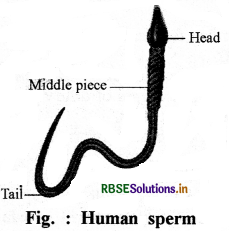
Structure of sperm:
The testes produce the male gametes called sperms. Millions of sperms are produced by the testes. They are very small in size. Each has a head, a middle piece and a tail.

Question 3.
Draw a labelled diagram of male reproductive organ in human.
Answer:
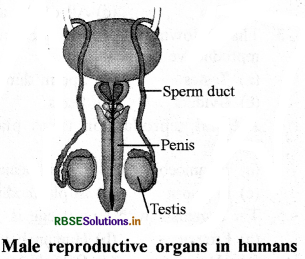
Question 4.
Write the names of different parts of female reproductive organs. Explain the structure of ovum.
Answer:
The reproductive organs in the female include a pair of ovaries, oviducts and uterus.
Structure of ovum:
Ovary produces female gametes called ova (eggs). In human being (female), a single matured egg is released into the oviduct by one of the ovaries every month. This is a single cell.

Question 5.
Draw a labelled diagram of female reproductive organs in humans.
Answer:
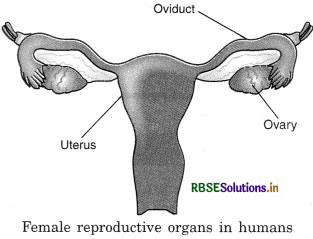
Question 6.
What do you mean by IVF (in vitro fertilization)? Explain.
Answer:
In some women oviducts are blocked. These women are unable to bear babies because sperms cannot reach the egg for fertilization. In such cases, doctors collect freshly released egg and sperms and keep them together for a few hours for IVF or in vitro fertilization (fertilization outside the body).
In case fertilization occurs, the zygote is allowed to develop for about a week and then it is placed in the mother's uterus. Complete development takes place in the uterus and the baby is born like any other baby. Babies bom through this technique are called test - tube babies. This term is actually misleading because babies cannot grow in test tubes.

Question 7.
What is external fertilization? How does this process take place in frogs?
Answer:
External fertilization:
Fertilization in which the fusion of a male and a female gamete takes place outside the body of the female is called external fertilization. During spring or rainy season, frogs and toads move to ponds and slow-flowing streams. When the male and female come together in water, the female lays hundreds of eggs. Unlike hen's egg, frog's egg is not covered by a shell and it is comparatively very delicate.
A layer of jelly holds the eggs together and provides protection to the eggs. As the eggs are laid, the male deposits sperms over them. Each sperm swims randomly in water with the help of its long tail. The sperms come in contact with the eggs. This results in fertilization. This type of fertilization is called
external fertilization.
Question 8.
Internal fertilization takes place in hen even then it lays eggs. Why?
Answer:
In hen internal fertilization takes place but it lays eggs, but does not give birth to babies. The reason is : that in hen soon after fertilization, the zygote is formed, the zygote divides repeatedly and travels down the oviduct. As it travels down, many protective layers are formed around it. The hard shell that you see in a hen's egg is one such protective layer. After the hard shell is formed around the developing embryo, the hen finally lays the egg.
The embryo takes about 3 weeks to develop into a chick. You must have seen the hen sitting on the eggs to provide sufficient warmth. After the chick is completely developed it bursts open the egg shell. In animals which undergo external fertilization, development of the embryo takes place outside the female body. The embryos continue to grow within their egg coverings. After the embry os develop, the eggs hatch.
Question 9.
What is meant by viviparous and oviparous animals? Clearly explain.
Answer:
Viviparous:
The animals which give birth to young ones are called viviparous animals; e.g. cow, cat, dog, etc. They do not lay eggs, the mother gives birth to developed young ones. They are called viviparous.
Oviparous:
Those animals which lay eggs are called oviparous animals; e.g. frog, lizard, butterfly, etc. These animals lay eggs and the young ones develop inside the egg.

Question 10.
What will be the effect on reproduction if the ovaries are removed from the female's body?
Answer:
Fusion of sperm and ovum takes place in the ovaries of the female body, which forms zygote which further develops and transforms into a child (infant). Removal of ovaries from the female body will not result in gamete fusion which will stop reproduction.
Essay Type Questions
Question 1.
What is sexual reproduction? Explain the dovelopment of zygote and embryo in human with labelled diagram.
Or
Explain the process of embryo development in human.
Answer:
Sexual reproduction:
Such reproduction in which male and female gamete fuse is called sexual reproduction.
Zygote formation and development of embryo in human:
During the reproductive process in human when sperm comes in contact with an egg, one of the sperms may fuse with the egg. Such fusion of the egg and the sperm is called fertilisation. During fertilisation, the nuclei of sperm and the egg fuse to form a single nucleus. This results in the formation of a fertilised egg or zygote.
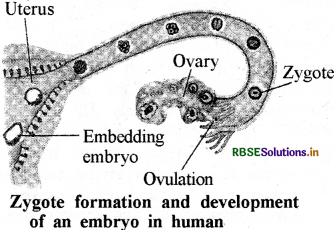
The zygote begins to develop into an embryo. The zygote divides repeatedly to give rise to a ball of cells. The cells then begin to form groups that develop into different tissues and organs of the body. This developing structure is termed an embryo. The embryo gets embedded in the wall of the uterus for further development.
The embryo continues to develop in the uterus. It gradually develops body parts such as hands, legs, head, eyes, ears, etc. The stage of the embryo in' which all the body parts can be identified is called a foetus. When the development of the foetus is complete, the mother gives birth to a baby.

Question 2.
What is fertilization? How many types of fertilization are there in animals? Write names. Describe the process of fertilization with diagram.
Answer:
Fertilization:
When male sperms come in contact with the female egg, one of the sperms may fuse with the egg. Such fusion of the egg and the sperm is called fertilization.
Type: In animals there are two types of fertilization:
- Internal fertilization
- External fertilization.
Fertilization process:
The testes produce the male gametes called sperms. Millions of sperms are produced by the testes. Ovary produces female gametes called ova (eggs). When sperms come in contact with an egg, one of the sperms may fuse with the egg. Such fusion of the egg and the sperm is called fertilization. During fertilization, the nuclei of the sperm and the egg fuse to form a single nucleus. This results in the formation of a fertilized egg or zygote.
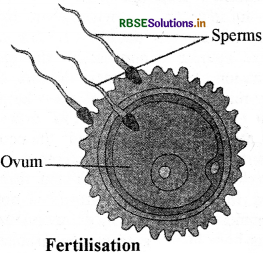
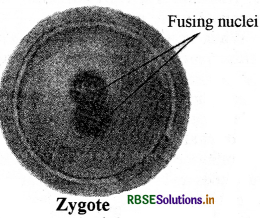
Question 3.
Explain with diagram the metamorphosis process in frog.
Or
What is metamorphosis? Explain the development of adult from egg in frog with labelled diagram.
Answer:
Metamorphosis:
The transformation of the larva into adult through drastic changes is called metamorphosis.
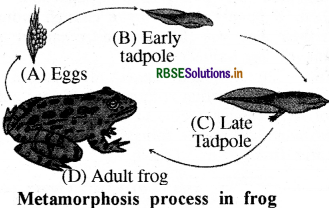
There are different stages of frog starting from the egg to the adult stage. There are three distinct stages, that is (i) egg, (ii) tadpole (larva), (iii) adult. Female frog lays egg in water, there by sperms external fertilization takes place. After fertilization tadpole (larva) comes out from egg. Its characters are similar to that of a fish and has no similarity with frog. After various changes a tadpole transforms into an adult frog.

Question 4.
What is clone? Explain the process of cloning in animals.
Answer:
Clone:
Cloning is the artificial production of an exact copy of a cell, any other living part, or a complete organism is known as cloning.
Animal cloning:
Cloning was performed for the first time by Dr. Ian Wilmut and his colleagues. In this process they collected the cells from the mammary gland of a female sheep and placed in nutrientless culture medium so that the division of these cells stopped and active gene stopped to work. Now' nucleus was removed from the mammary gland cell.
Simultaneously an egg was obtained from other female sheep. The nucleus was removed from the egg. Then, the nucleus of the mammary gland cell was inserted in nucleusless egg cell and by electrical stimulation it was allowed to fuse.
Thus mother nucleus is established in this eggcell. The egg thus produced was implanted in uterus of other (host mother) sheep, it developed in the form of a lamb. In this way Dolly was bom. It was genetically identical (clone) of his mother. Its first nucleus was taken from mother sheep cell, so genetically it is the clone of mother sheep.
Question 5.
What are the characters of asexual reproduction? Write the use and harm of asexual reproduction.
Answer:
Characters of asexual reproduction:
- In this process only a single parent is involved. Opposite sex does not take part.
- Developed individuals are genetically identical to parents.
- Asexual reproduction demonstrates the fast rate of division.
Uses of asexual reproduction:
Asexual reproduction is simple and having the fast rate.
Harm of asexual reproduction:
- Evolutionary variation is not possible in individual. Individual is not able to change according to environmental variations.
- Genetically defects pass from parents to offspring.
